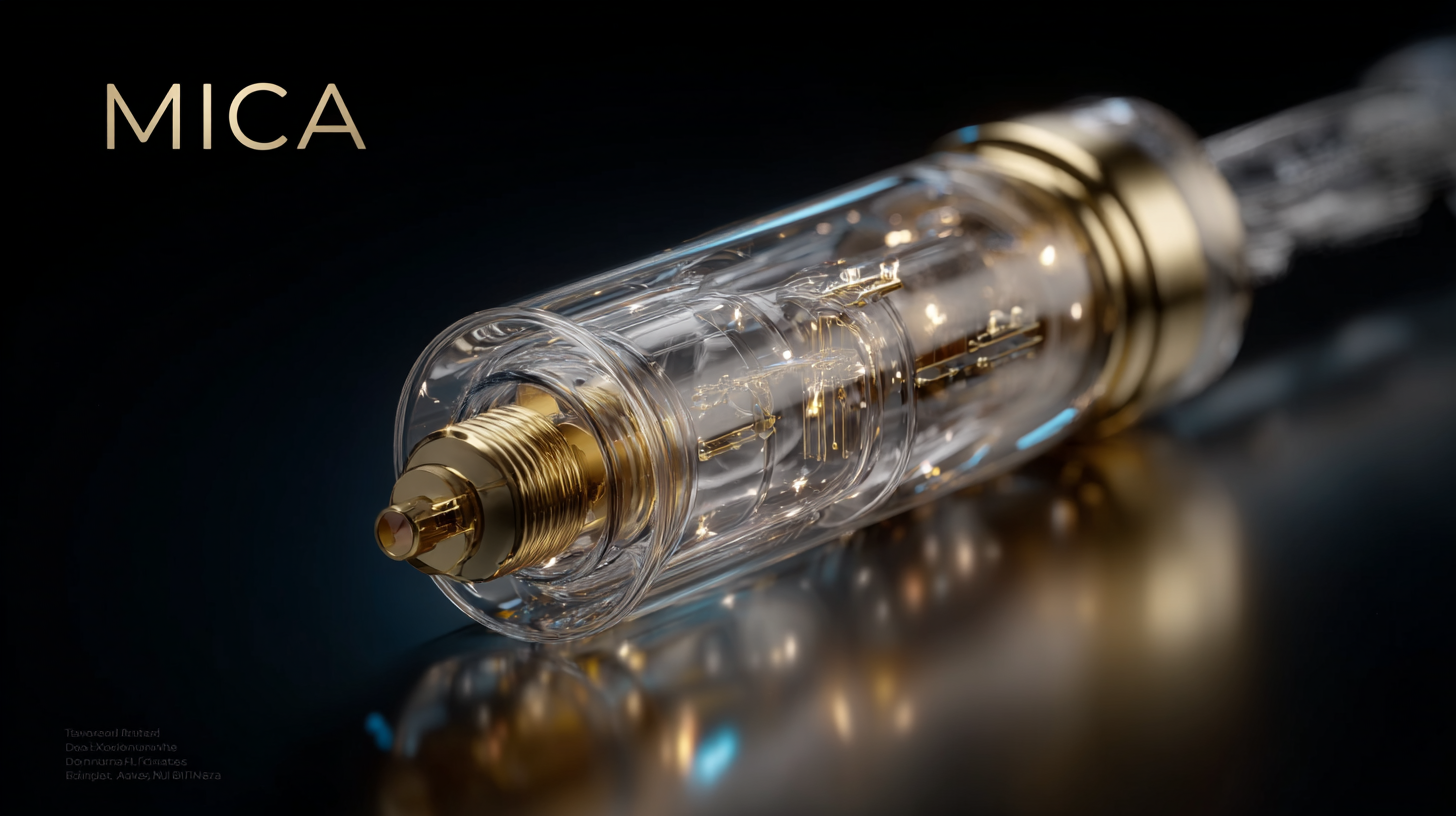QR Code
About Us
Products
Contact Us

Phone

Fax
0086-574-87527773

E-mail

Address
No 432 Zhenhai Middle Road, Luotuo Street, Zhenhai District, Ningbo City, Zhejiang China
As we venture into 2025, the demand for innovative materials in various industries continues to rise, with mica tube technology emerging as a pivotal focus. According to a recent industry report by MarketsandMarkets, the mica-based products market is projected to reach USD 1.2 billion by 2025, driven by their exceptional thermal and electrical insulation properties. Mica tubes are increasingly being utilized in sectors ranging from electrical engineering to automotive manufacturing, highlighting their versatility and efficiency.
 Moreover, as sustainability becomes central to manufacturing processes, the ability of mica tubes to withstand high temperatures and corrosion adds a critical edge to their marketability. In this blog, we will explore the latest trends and innovations in mica tube applications, equipping you with insights on how to effectively navigate this evolving landscape for your business and technological needs.
Moreover, as sustainability becomes central to manufacturing processes, the ability of mica tubes to withstand high temperatures and corrosion adds a critical edge to their marketability. In this blog, we will explore the latest trends and innovations in mica tube applications, equipping you with insights on how to effectively navigate this evolving landscape for your business and technological needs.
As the deadline for full compliance with the Markets in Crypto-Assets (MiCA) regulation approaches in 2025, the crypto landscape is set to undergo significant transformations that will redefine industry standards. One key area of impact is the Decentralized Finance (DeFi) sector. According to recent statistics, by 2025, nearly 45% of DeFi platforms will adapt their functionalities to meet MiCA compliance requirements, enabling greater user security and innovation. This shift is not merely regulatory; it is a catalyst for new product developments that aim to enhance user trust and interoperability in the ecosystem.
In addition to DeFi, the MiCA regulations will dramatically reshape the landscape for crypto lending and staking. Reports indicate that the number of compliant crypto lending platforms is expected to increase by over 60% by 2025, resulting in safer borrowing environments for users. The emphasis on regulatory compliance is enticing more traditional financial institutions to explore crypto investments, with a projected market capitalization growth of 25% in the sector during this transitional period. As these innovations emerge, they will not only adhere to regulations but will also pave the way for groundbreaking financial technology advancements that prioritize transparency and user empowerment.
| Trend/Innovation | Description | Expected Impact | Adoption Rate (%) | Compliance Standards |
|---|---|---|---|---|
| Eco-Friendly Mica Tubes | Tubes made from sustainable mica sources, reducing environmental impact. | Decreased carbon footprint and improved brand sustainability. | 65% | ISO 14001 |
| High-Performance Insulation | Advanced insulation properties enhancing thermal and electrical resistance. | Greater energy efficiency in applications. | 75% | IEC 60068 |
| Customizable Mica Tubes | Tubes available in various sizes and coatings for specific applications. | Enhanced usability across industries. | 55% | ASTM D150 |
| Nano-Coating Technologies | Nanotechnology applied to improve surface properties and durability. | Longer lifespan and reduced wear and tear. | 50% | REACH |
| Smart Mica Tubes | Integration of sensors for real-time tracking of conditions. | Improved maintenance and monitoring capabilities. | 40% | ISO/IEC 27001 |
The mica tube industry is witnessing a significant transformation driven by the increased emphasis on
sustainable materials. As environmental consciousness grows, manufacturers are compelled to evaluate their production
processes and raw material sources. By integrating sustainable alternatives, such as biodegradable resins and recycled mica, the industry can drastically
reduce its carbon footprint while maintaining product integrity. This shift not only caters to eco-friendly consumers but also aligns with global
sustainability goals, making it a strategic imperative for businesses in 2025.
Innovations in sustainable materials are reshaping the production of mica tubes. Advances in technology enable manufacturers to develop products that are
both functional and eco-conscious. For instance, innovations such as water-based coatings reduce harmful emissions during production, while incorporating
renewable energy sources in manufacturing processes minimizes reliance on fossil fuels. This holistic approach to sustainability not only enhances product
appeal but also fosters a responsible image among consumers who increasingly prioritize environmental stewardship in their purchasing decisions. As these
trends continue to evolve, the mica tube industry could set a new standard for combining performance with sustainability.

In the realm of high-temperature applications, mica tubes have emerged as a vital component due to their excellent thermal resistance and electrical insulation properties. Comparing performance metrics across different mica tube trends showcases significant innovations that enhance their capabilities. The latest advancements include improved construction techniques and enhanced material composition, which allow mica tubes to withstand extreme conditions without compromising safety or efficiency.
When selecting mica tubes for high-temperature applications, consider conducting thorough performance evaluations. Pay attention to thermal conductivity and dielectric strength, ensuring that the selected tubes can effectively manage heat while maintaining electrical performance. Additionally, opting for tubes with enhanced durability can prevent premature failure and reduce maintenance costs.
Tip: Always consult manufacturer specifications to understand the temperature limits and ratings of mica tubes, as this knowledge is crucial for ensuring optimal performance in your specific application. Additionally, consider the environment in which the mica tubes will be used, as factors like humidity and contaminants can significantly impact their longevity and performance.
As the mica tube manufacturing industry evolves, compliance with regulatory frameworks has become increasingly significant. Manufacturers face a range of challenges, including stringent environmental regulations and industry standards aimed at ensuring product safety and sustainability. These regulations often require companies to reassess their production processes, from sourcing mica to final product delivery, pushing them towards more sustainable practices. Adhering to these standards not only helps mitigate the impact on the environment but also enhances brand reputation among environmentally conscious consumers.
Moreover, the complexities of international trade regulations present an additional hurdle for mica tube manufacturers. Companies must navigate varying requirements across different regions, which can complicate supply chains and increase operational costs. Staying updated on regulations related to labor practices in mica mining and the potential for illegal sourcing is crucial for maintaining compliance. As the industry progresses towards 2025, embracing innovative compliance solutions, such as blockchain technology for traceability, will likely become a vital strategy for manufacturers aiming to overcome these regulatory challenges while fostering sustainable growth.

As we delve into the future of mica tubes, the year 2025 promises significant growth opportunities driven by advancements in technology and increasing demand across various sectors. Mica tubes, recognized for their insulation properties and resilience to high temperatures, are becoming integral components in industries such as electronics, automotive, and aerospace. Projections indicate that the market for mica tubes is poised to expand, fueled by innovations that enhance their performance characteristics and application versatility.
Technological advancements are set to play a critical role in shaping the future of mica tubes. The development of new manufacturing techniques and materials is expected to improve the efficiency of mica tubes, making them more cost-effective and adaptable to specific industry needs. Additionally, as sustainability becomes a focal point in manufacturing processes, eco-friendly alternatives and recycling methods for mica tubes are anticipated to emerge, aligning with global efforts to reduce waste and promote responsible production practices. These trends highlight the exciting trajectory for mica tubes as they integrate more seamlessly into modern technological applications.
This chart illustrates the projected growth percentage of the mica tube market from 2021 to 2025. The data indicates a steady increase in market growth, highlighting significant opportunities and technological advancements within the industry.


0086-574-87527773


No 432 Zhenhai Middle Road, Luotuo Street, Zhenhai District, Ningbo City, Zhejiang China
Copyright © 2015-2024 Ningbo Nafty Sealing Materials Co., Ltd. All Rights Reserved.
| | | XML | Privacy Policy |
TradeManager
Skype
VKontakte
